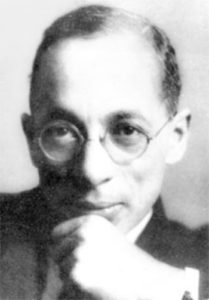
Elmer Imes
*Elmer Imes was born on this date in 1883. He was a Black scientist specializing in physics.
Born in Memphis, Tennessee, Elmer Samuel Imes, the son of Elizabeth (née Wallace) and Benjamin A. Imes, both of whom were college-educated and had met at Oberlin College in Ohio. They married there in 1880. His father earned a divinity degree at Oberlin Theological Seminary in 1880. Benjamin was descended from free non-whites established in south-central Pennsylvania by the time of the Revolution. His mother, Elizabeth, was born into slavery; her family had moved to Oberlin when she was a child after the American Civil War. Imes had two younger brothers: Albert Lovejoy Imes and William Lloyd Imes. The latter became a minister and was later pastor of St. James Presbyterian Church in New York City.
Imes and his brothers attended grammar school in Oberlin, Ohio. Their parents became missionaries with the American Missionary Association and moved to the South to serve freedmen and their children. Imes completed his high school education at the Agricultural and Mechanical High School in Normal, Alabama. He graduated in 1903 from Fisk University, a historically black college, with a bachelor's degree in science. Upon graduating, Imes taught mathematics and physics at Georgia Normal and Agricultural Institute (now Albany State University) in Albany, Georgia, and the Emerson Institute. Imes returned to Fisk in 1913 as an instructor of science and mathematics. During his tenure there, Imes also earned a master's degree in science from Fisk University.
He went to the University of Michigan for additional study in physics, earning a Ph.D. in physics in 1918. He studied under Harrison McAllister Randall. Imes was the second African American to receive a Ph.D. in physics since Edward Bouchet graduated from Yale University in 1876; Imes was the first Black man in the 20th century to gain this degree. On May 3, 1919, after moving to New York to work in industry, Imes married Nella Larsen, a nurse who became a writer. A woman of Danish and Afro Caribbean descent, she is considered part of the Harlem Renaissance and published short stories and two novels in the late 1920s. The couple had moved from Jersey City, New Jersey, to Harlem, where they became part of the professional and cultural society that included artists and intellectuals such as Langston Hughes and W.E.B. Du Bois, members of the black elite.
In those years, Imes found it difficult to secure employment in academia. Not many Black colleges had physics programs, and white colleges did not hire him. As a result, he became a physics consultant and researcher after completing his doctorate; he worked in physics at the Federal Engineers Development Corporation in 1918 and with the Burrows Magnetic Equipment Corporation in 1922. In 1927, Imes went to work as a research engineer at E.A. Everett Signal Supplies. During the decade that Imes worked in the scientific and materials industry, his research resulted in four patents for instruments used to measure magnetic and electric properties. In 1930, Imes returned to Fisk University, where he served as Chair of the Physics Department. Imes is credited with the academic development of the physics programs at Fisk. Many of his students obtained doctoral degrees from highly-ranked schools such as the University of Michigan.
While at Fisk, Imes developed a course in Cultural Physics to teach students about the history of science. 1931, Imes was named one of the thirteen most gifted black Americans. Due to strains in their marriage, they divorced in 1933. Imes returned to Fisk University in 1929 for an academic career, developing and leading its physics department. Imes’ research and doctoral thesis led to his publication of Measurements on the Near-Infrared Absorption of Some Diatomic Gases in November 1919 in the Astrophysical Journal. This work was followed by a paper co-authored and presented in November 1919 jointly with Harrison M. Randall, "The Fine Structure of the Near Infra-Red Absorption Bands of HCI, HBr, and HF" at the American Physical Society; it was published in the Physical Review in February 1920.
This work demonstrated for the first time that Quantum Theory could be applied to radiation in all regions of the electromagnetic spectrum, to the rotational energy states of molecules, as well as the vibration and electronic levels. His work provided an early verification of Quantum Theory. It became known in Europe as well as in the United States. His work was one of the earliest applications of high-resolution infrared spectroscopy and provided the first detailed spectra of molecules. This led to the development of the field of study of molecular structure through infrared spectroscopy. In 1939, Imes returned to New York, where he conducted research as a scholar in magnetic materials at the Physics Department at New York University. While working in the industry, he gained four patents for instruments to measure magnetic and electric properties. As an academic, he developed and chaired the Department of Physics at Fisk University from 1930 to 1941 and died on September 11, 1941.